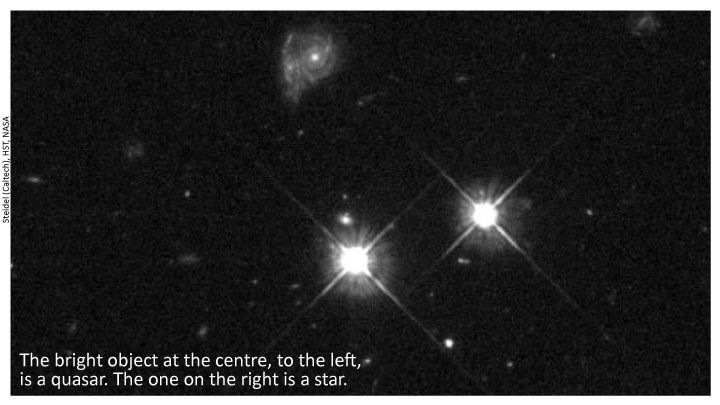

















Triton, Neptune’s largest moon, was a bit upset. She gave a special space call to her best friend, our Moon. Our special Tinkle satellites picked up on it. “I miss you, Moony. Why are you so far away from me?” Comforting her, the Moon said, “We are not all that far away, Triton! Let me tell you about what lies at some of the most distant points of space.”
Here’s a run-down of the two best friends’ conversation, where they discuss quasars (pronounced kway-zaars)!
In fact, they are some of the brightest and, with respect to the Earth, the most distant objects in the known universe. They are a part of a group of objects called QSOs or quasi-stellar objects, which in turn are part of a larger group called AGNs or “active galactic nuclei”. These larger groups involve similar bodies that might not emit radiation as strongly, and might not be as bright, respectively.
The definition of quasars mentioned that they radiate. Well, they give off radio waves very strongly. Radio waves are a type of invisible wave which help us communicate and transmit other data to each other. A transmitter emits them and a receiver picks up on them. Quasars were discovered when powerful receivers were used in the 1950s to search the sky for possible radio sources. They looked like stars and were therefore named “quasi-stellar radio sources”. In 1964, this was shortened to “quasar”!
Remember how quasars are part of a large group called “active galactic nuclei”? “Galactic nuclei” also implies that these exist at galaxy centres. In fact, quasars get their energy from the gas that is spiraling as it falls into a gigantic black hole known as a “supermassive black hole” (having mass between about a million to a few billion times that of the Sun). These gas particles, while spinning into the black hole due to its strong gravitational pull, gain speed and therefore heat and energy, which power the quasar.
The brightest known quasar is named 3C 273. Such quasars can even make the light from all these stars appear dull in comparison to their own. This brightness causes them to be visible even from billions of light years away. Moreover, they have a mass of about millions of stars, but are still just about the size of our solar system. Such a small body with so much energy is made possible because it is powered by gas spinning into black holes, as mentioned above. That is what makes them special.
Another interesting thing about some quasars is that they emit radio jets. These are jets of plasma that are shot out at nearly the speed of light! Plasma is the fourth state of matter apart from solids, liquids, and gases, which can be created by adding a lot of energy to a gas so that its atoms get their negatively charged particles, electrons, broken free from them.


They are mostly found by taking images of the sky using a few coloured filters, and then comparing them to locate the objects that are bluer than the others. Then, other methods are used to verify what these are.
After all this, Triton began dreaming about the far-away wonders of the universe, and Moon succeeded in convincing her that the two of them are not so far away after all. We’re just glad to have overheard them and we hope you enjoyed learning about quasars too. Happy Space Week!
Click here to learn about NASA’s Artemis Program